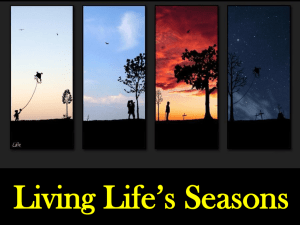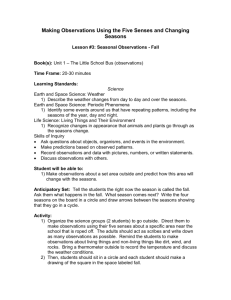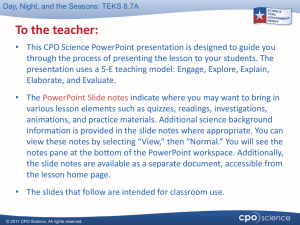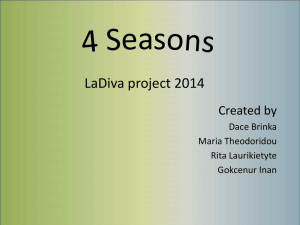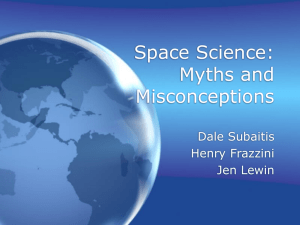SS.GradeK - NCAIGIRP
advertisement
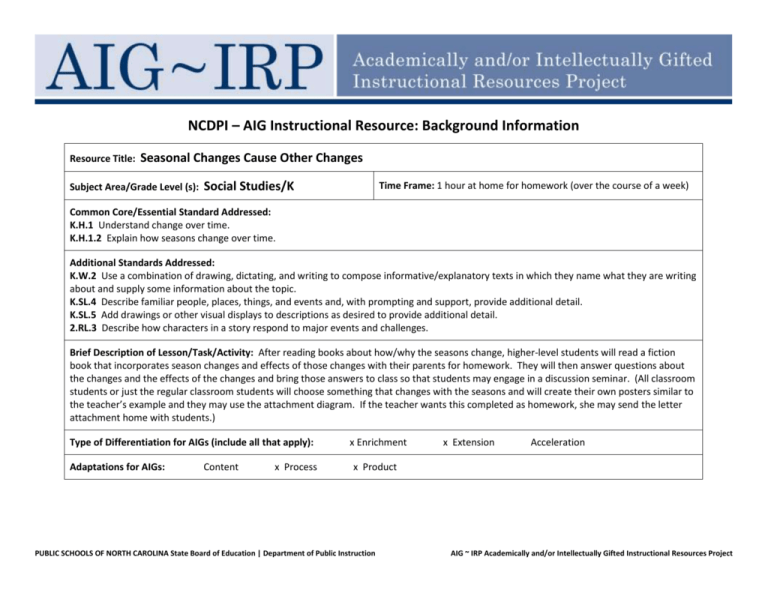
NCDPI – AIG Instructional Resource: Background Information Resource Title: Seasonal Changes Cause Other Changes Subject Area/Grade Level (s): Social Studies/K Time Frame: 1 hour at home for homework (over the course of a week) Common Core/Essential Standard Addressed: K.H.1 Understand change over time. K.H.1.2 Explain how seasons change over time. Additional Standards Addressed: K.W.2 Use a combination of drawing, dictating, and writing to compose informative/explanatory texts in which they name what they are writing about and supply some information about the topic. K.SL.4 Describe familiar people, places, things, and events and, with prompting and support, provide additional detail. K.SL.5 Add drawings or other visual displays to descriptions as desired to provide additional detail. 2.RL.3 Describe how characters in a story respond to major events and challenges. Brief Description of Lesson/Task/Activity: After reading books about how/why the seasons change, higher-level students will read a fiction book that incorporates season changes and effects of those changes with their parents for homework. They will then answer questions about the changes and the effects of the changes and bring those answers to class so that students may engage in a discussion seminar. (All classroom students or just the regular classroom students will choose something that changes with the seasons and will create their own posters similar to the teacher’s example and they may use the attachment diagram. If the teacher wants this completed as homework, she may send the letter attachment home with students.) Type of Differentiation for AIGs (include all that apply): Adaptations for AIGs: Content x Process x Enrichment x Extension Acceleration x Product PUBLIC SCHOOLS OF NORTH CAROLINA State Board of Education | Department of Public Instruction AIG ~ IRP Academically and/or Intellectually Gifted Instructional Resources Project Explanation of How Resource is Appropriate for AIGs: This task is appropriate for higher-level students because while the student continues to work with the Essential Standard for his grade level, he will also extend his learning by engaging in deep discussion (Paideia Seminar) to answer questions which require critical thinking skills. Needed Resources/Materials: Books to read about season changes: • The Reasons for Seasons by Gail Gibbons • The Seasons of Arnold’s Apple Tree by Gail Gibbons • Ocean Seasons by Ron Hirschi • Four Seasons Make a Year by Anne Rockwell • The Year at Maple Hill Farm by Alice and Martin Provensen • Poster Board • Letter to Parents (attached) • Sample Poster (attached) • Pre-Seminar Questions (attached) • Magazine pictures or clipart that show people, animals, or natural items in different seasons Sources : NA TEACHER NOTES: The teacher should find books that show why seasons change like The Reasons for Seasons by Gail Gibbons. Then she should read books about how things change throughout the seasons like The Year at Maple Hill Farm by Alice an Martin Provensen, which describes the changes in animals or The Seasons of Arnold’s Apple Tree by Gail Gibbons, which shows the changes in an apple tree over seasons. She will also need to choose a book such as The Ox-Cart Man by Donald Hall. PUBLIC SCHOOLS OF NORTH CAROLINA State Board of Education | Department of Public Instruction AIG ~ IRP Academically and/or Intellectually Gifted Instructional Resources Project NCDPI AIG Curriculum Resource Outline STAGE ONE: ENGAGE The teacher can find pictures of things in nature or people that represent different seasons and have the students identify which season this would represent (if we live in NC—following our seasonal changes). How do you know? The teacher may also read books about the changing of seasons and books that exemplify changes that happen to animals, trees, nature, and people as the seasons change, or students may explore these books in pairs of small groups and then share with the whole group the changes that they noticed. The teacher will demonstrate how to make a poster to show changes caused by the seasons in one item (ex. a tree, clothes that people wear, an animal). She can show different items and how they change on her poster. Then the whole class will create posters of their own, choosing a different item from the teacher to complete their own posters (or this could just be the regular classroom students). (There is an attachment to demonstrate a template of what the posters would look like.) STAGE TWO: ELABORATE Higher level students will read Ox-Cart Man by Donald Hall at home for homework with the help of their parents. They will answer the attached pre-seminar questions with parents’ help. They will bring the questions/answers to class, and they will participate in a Paideia seminar with the teacher (facilitator) to discuss how the seasons impact changes in nature, changes in humans’ lives, changes in animals’ lives, and the decisions that humans make based on the changes. There is an attachment of Pre-Seminar questions for students to answer on their own, and these same questions will be used for the Paideia seminar. STAGE THREE: EVALUATE The teacher will assess students’ understanding of the concept of changing seasons over time by asking questions while creating the poster with the class. If she uses an apple tree for her poster example, she may show the apple tree in spring with all of its blossoms, and ask what will the tree look like or have in Summer? In Fall? In Winter? If she uses the front lawn of the school as an example, she may say in spring we see flowers on the bushes and plants; what does it look like in Summer? In Fall? In Winter? If students can articulate what an item may look like/be like in the next season, he is demonstrating an understanding of how different items are changed by the seasons. As higher level students bring in their questions that they answered after reading Ox-Cart Man, the teacher will assess students to see if they answer questions with a lot of thought and use critical thinking skills. If the teacher wants to make sure that students do their own thinking rather than have parent influence or help, she may have students read the book at home, but answer the pre-seminar questions at school. TEACHER NOTES: If the teacher has not conducted a Paideia seminar before, she can read about the seminars online and the protocol for doing a seminar or she can just discuss the questions with the students, allowing all students to comment on each question and what other students in the group have said. PUBLIC SCHOOLS OF NORTH CAROLINA State Board of Education | Department of Public Instruction AIG ~ IRP Academically and/or Intellectually Gifted Instructional Resources Project

